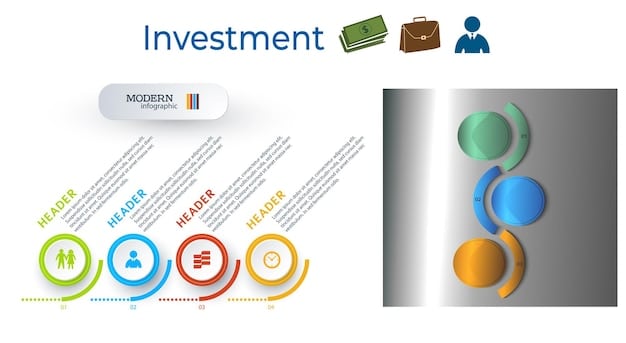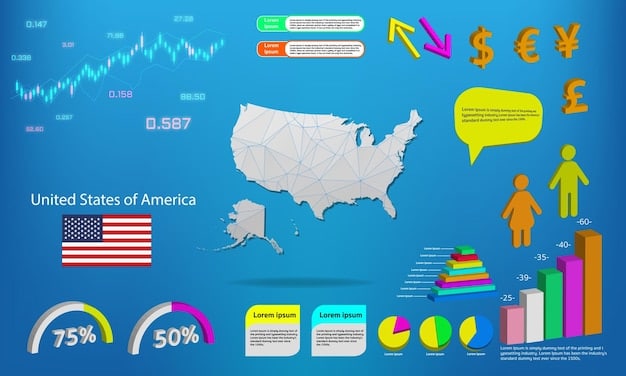US Corporate Tax Regulations 2025: Impact on Business Growth

The novel corporate tax regulations for 2025 are poised to significantly reshape the operational landscape and strategic growth trajectories for businesses across the U.S. by introducing new compliance requirements and altered financial incentives.
As 2025 approaches, businesses nationwide are keenly observing the horizon for new corporate tax regulations. The question on everyone’s mind is clear: How will the new corporate tax regulations impact US business growth in 2025? This isn’t just about numbers on a ledger; it’s about the very fabric of how companies plan, invest, and expand in the coming years. Understanding these changes is crucial for strategic planning and maintaining a competitive edge.
Understanding the Proposed Tax Reforms for 2025
The landscape of corporate taxation in the United States is perennially dynamic, with proposed reforms frequently brought to the fore, signaling potential shifts in how businesses operate and strategize. For 2025, several key proposals are nearing critical stages, many of which aim to address long-standing economic disparities or fund ambitious governmental initiatives. These anticipated changes are not merely incremental adjustments; they represent a potential conceptual overhaul, impacting everything from capital allocation to international trade.
Many of the discussions revolve around adjusting the corporate tax rate itself. Historically, this rate has fluctuated significantly, and even minor percentage point changes can lead to billions in revenue shifts. Beyond the headline rate, debates are also focused on specific deductions, credits, and allowances that companies currently leverage to manage their tax liabilities. The removal or modification of these provisions could compel businesses to re-evaluate their operational structures and investment strategies.
Key Areas of Proposed Change
Several distinct areas are under scrutiny for potential reform. These often include provisions that have been controversial or have shown an uneven impact across different sectors of the economy. Understanding these specific points is essential for any forward-thinking business.
- Corporate Tax Rate Adjustments: Proposals range from modest increases to significant overhauls of the statutory rate, aiming to either boost federal revenue or incentivize domestic investment.
- International Tax Provisions: Revisions to global intangible low-taxed income (GILTI) and base erosion and anti-abuse tax (BEAT) are being considered to prevent profit shifting and ensure a fairer international playing field.
- Capital Gains and Depreciation Rules: Changes to how depreciation is calculated and capital gains are taxed could influence investment cycles and the acquisition of new assets, crucial for manufacturing and tech sectors.
Additionally, smaller, yet impactful, reforms are being discussed concerning research and development (R&D) credits and various industry-specific incentives. These could significantly alter the cost-benefit analysis for innovation-driven companies, either fostering or hindering their growth depending on the final legislation. The interplay between these reforms creates a complex web that requires detailed analysis.
The underlying motivation for these reforms often stems from a desire to stimulate economic activity in specific areas, such as renewable energy or infrastructure, while simultaneously ensuring that corporations contribute equitably to the nation’s fiscal health. This delicate balancing act involves continuous negotiation and compromise among various political and economic stakeholders, making the final form of these regulations highly anticipated.
Direct Implications for Business Investment and Profitability
The direct impact of new corporate tax regulations on business investment and profitability is often the most immediate and tangible concern for companies. Any alteration to the tax code can ripple through financial statements, influencing everything from quarterly earnings to long-term strategic plans. Businesses, regardless of their size or sector, are highly sensitive to these shifts, as they directly affect their bottom line and capacity for expansion.
One of the primary areas of concern is the potential reduction in after-tax profits. If corporate tax rates increase, or if certain deductions and credits are curtailed, companies will find themselves with less disposable income. This reduction then directly impacts their ability to reinvest in their operations, fund R&D initiatives, or return capital to shareholders. Such scenarios can lead to a more conservative approach to investment, potentially slowing down innovation and job creation.
Capital Expenditure and Expansion
Capital expenditure (CapEx), which includes investments in property, plant, and equipment, is a critical driver of business growth. Tax policies that make CapEx more expensive or less financially attractive can deter companies from undertaking new projects. For example, changes in depreciation rules can significantly alter the timing and amount of tax deductions available for new assets.
- Impact on New Equipment Purchases: If accelerated depreciation benefits are reduced, companies might delay purchasing new machinery or technology, affecting productivity gains.
- Funding for New Facilities: Higher effective tax rates could shrink the pool of funds available for building new factories or offices, thereby limiting physical expansion.
- R&D Investment Incentives: Modifications to R&D tax credits can either incentivize or disincentivize innovation, directly influencing a company’s long-term competitive standing.
Moreover, the availability of capital for expansion hinges heavily on perceived returns, which are inherently tied to tax liabilities. When regulations create uncertainty or impose higher costs, businesses may opt for safer, lower-yield investments or postpone growth-oriented projects entirely. This cautious sentiment can spread across the economy, affecting broader market trends.

Another crucial element is the impact on global competitiveness. U.S. companies operating internationally often face complex tax structures. If American tax regulations become less favorable compared to other major economies, it could prompt some companies to reconsider where they locate their operations, invest their profits, or even register their intellectual property. Such decisions have far-reaching effects on domestic job markets and economic vitality.
Ultimately, the direct implications boil down to a trade-off. While increased corporate taxes might boost government revenue for public services, they can simultaneously reduce private sector capacity for investment and expansion. Businesses will need to meticulously analyze the precise nature of these regulations to adjust their financial models and strategic plans accordingly, maintaining profitability in a new fiscal environment.
Navigating Compliance and Administrative Burdens
Beyond the direct financial implications, new corporate tax regulations inevitably introduce a significant layer of compliance and administrative burdens for businesses. This aspect often gets less attention in public discourse but is a critical factor for companies, especially small and medium-sized enterprises (SMEs), which may lack the extensive legal and accounting resources of larger corporations. The complexity of new rules can divert valuable time and resources away from core business operations.
Every new regulation requires detailed interpretation, adjustments to internal accounting systems, and often, investments in new software or expert consultation. Companies must ensure their financial practices align perfectly with the updated tax code to avoid penalties, audits, and costly legal disputes. This process is not only time-consuming but also adds a layer of operational expense that might not have been factored into prior budgeting.
Increased Reporting Requirements
One common feature of tax reforms is an increase in reporting requirements. Governments often seek more detailed and transparent financial information to ensure compliance and prevent tax avoidance. For businesses, this translates into more intricate record-keeping and potentially new forms and schedules to file.
- Enhanced Data Collection: Companies might need to collect and categorize financial data in new ways to meet specific reporting criteria, requiring system upgrades.
- Specialized Software Needs: Investment in tax compliance software tailored to the new regulations can become essential, representing a significant upfront cost.
- Consultancy Expenses: Engaging tax attorneys and specialized accountants to interpret complex legislation and ensure accurate filing is often unavoidable, adding to operational overhead.
The administrative burden isn’t just about financial reports; it also extends to how businesses structure their internal operations and transactions. For instance, new international tax rules might necessitate changes in intercompany pricing policies or supply chain management to maintain compliance and optimize tax efficiency across borders. Failure to adapt these internal mechanisms can result in substantial financial penalties.
For smaller businesses, the impact can be disproportionately severe. Unlike large corporations with dedicated tax departments, SMEs often rely on external accountants or a limited internal finance team, whose capacity might be stretched thin by complex new regulations. This can lead to increased costs for professional services or, in some cases, a higher risk of non-compliance due to lack of resources and expertise. Navigating this labyrinth requires careful planning and potentially significant financial outlay, diverting funds that could otherwise be used for growth initiatives.
Impact on Different Business Sectors and Industries
The sweeping nature of new corporate tax regulations rarely affects all industries uniformly. Instead, specific sectors are often disproportionately impacted due to their unique operational models, revenue streams, and investment patterns. Understanding these differential effects is crucial for businesses within these sectors to anticipate challenges and opportunities, allowing for tailored strategic responses.
For instance, capital-intensive industries such as manufacturing, infrastructure development, and energy often feel the brunt of changes in depreciation rules or investment tax credits more acutely than service-based industries. These sectors rely heavily on significant upfront capital outlays for machinery, facilities, and R&D, making them particularly sensitive to policies that alter the cost or benefit of such investments. A reduction in accelerated depreciation, for example, could substantially increase the effective cost of new projects, potentially slowing down modernization and expansion efforts.
Sector-Specific Vulnerabilities and Opportunities
Each sector has its own set of vulnerabilities and potential opportunities under new tax regimes. The tech industry, with its heavy reliance on intangible assets like intellectual property and R&D, will be closely watching changes to R&D credits and international tax provisions that govern profit shifting.
- Technology Sector: Highly sensitive to R&D tax credits and provisions affecting intellectual property, as these directly influence innovation cycles and global market competitiveness.
- Manufacturing and Energy: Heavily impacted by depreciation rules, investment tax credits, and policies promoting clean energy, which can either stimulate or decelerate capital expenditures.
- Retail and Consumer Goods: Might be more affected by broader economic conditions stemming from tax changes, such as consumer spending power or supply chain costs, rather than direct corporate rate adjustments.
- Financial Services: Often face specific regulations related to capital gains, financial transaction taxes, and international banking rules, making them highly responsive to legislative nuances.
Conversely, some sectors might find new opportunities. For example, if tax credits are introduced for specific activities like sustainable energy adoption or workforce development, businesses engaged in these areas or those willing to pivot could see a competitive advantage. This could spur investment in environmentally friendly technologies or job training programs, fostering growth in new directions.
The cascading effects are also important. Changes impacting one sector, such as increased production costs in manufacturing, can ripple through the supply chain, affecting distributors, retailers, and ultimately consumers. This interconnectedness means that even seemingly isolated tax adjustments can have broad economic consequences. Businesses must undertake detailed sector-specific analyses to truly understand the customized impact of new corporate tax regulations on their growth prospects.
Potential for Economic Stimulus or Contraction
New corporate tax regulations inherently carry the potential to either stimulate or contract the broader U.S. economy. This macroeconomic impact is a critical consideration for policymakers and businesses alike, as it dictates the overall environment in which companies will operate and grow. The ultimate effect depends heavily on the specific design of the regulations and how businesses and consumers react to them.
A stimulus effect typically occurs when tax reductions or incentives encourage companies to invest more, hire more employees, and increase wages, leading to greater consumer spending and overall economic activity. Conversely, a contraction can arise if higher taxes or increased compliance costs deter investment, leading to slower growth, job losses, or businesses relocating capital elsewhere. The key is finding a balance that supports both government revenue needs and private sector dynamism.
Factors Influencing Economic Outcomes
Several factors contribute to whether specific tax regulations lead to economic expansion or deceleration. These include the magnitude of tax rate changes, the efficacy of targeted incentives, and the psychological impact on business confidence.
- Consumer Spending: If tax changes influence corporate behavior resulting in wage increases or job creation, consumer confidence and spending might rise, stimulating demand.
- Inflationary Pressures: Increased corporate costs due to taxes could be passed on to consumers through higher prices, potentially fueling inflation and reducing purchasing power.
- Foreign Investment: The U.S. tax environment compared to other nations will influence whether foreign companies invest in the U.S. and whether American companies repatriate profits.
- Market Confidence: Uncertainty or perceived unfavorable changes in tax policy can dampen investor confidence, leading to stock market volatility and reduced capital flows.
For example, if the new regulations include substantial tax credits for green technologies or infrastructure projects, this could spur innovation and job growth in those specific sectors, leading to a targeted economic stimulus. However, if these benefits are offset by higher taxes elsewhere, the overall net effect might be more neutral or even negative. The interplay of various provisions is complex, making precise predictions challenging.

Moreover, the timing of these regulations is paramount. Introducing significant tax increases during an economic downturn, for instance, could exacerbate a recession by further discouraging investment. Conversely, well-calibrated incentives during a period of stability could provide a timely boost. Businesses must remain agile, adapting their strategies to both the micro and macro-economic shifts induced by these tax reforms to either harness opportunities or mitigate risks. The path to growth will depend on navigating this delicate dynamic effectively.
Strategic Adjustments for Businesses in 2025
In anticipation of new corporate tax regulations in 2025, proactive businesses are already considering the strategic adjustments necessary to maintain competitiveness and profitability. This forward-thinking approach involves more than just financial planning; it encompasses a holistic review of operational structures, investment priorities, and even talent management. Companies that adapt quickly and intelligently will be better positioned to thrive in the evolving tax landscape.
One of the most critical adjustments will be a thorough reassessment of capital allocation. If certain types of investments become less tax-advantageous, businesses might shift focus to areas that still offer strong returns or newly introduced tax incentives. This could involve re-evaluating expansion plans, R&D budgets, and decisions regarding mergers and acquisitions. The goal is to optimize the deployment of capital to maximize after-tax returns, aligning investment decisions with the new fiscal realities.
Key Strategic Adaptations
Businesses will need to explore several key areas for strategic adaptation to effectively navigate the new tax environment. This could range from restructuring debt to optimizing supply chains.
- Re-evaluating Investment Portfolios: Prioritizing investments that generate tax-preferred income or qualify for new credits, such as those related to sustainability or domestic production.
- Optimizing Capital Structure: Reviewing debt-to-equity ratios and financing options, as interest deductibility rules could change, affecting overall borrowing costs and tax efficiency.
- Supply Chain Realignment: Analyzing the tax implications of international supply chains and potentially reshoring operations or adjusting global logistics to minimize tax liabilities and enhance resilience.
- Technology Adoption: Investing in advanced financial technology and AI tools to improve tax compliance, data analysis, and predictive modeling, thereby reducing administrative burdens and errors.
Furthermore, human capital strategy will play an increasingly important role. Attracting and retaining top talent, especially those with specialized skills in tax law and financial compliance, will be paramount. Companies might need to invest in training existing staff or hiring new experts to navigate the complexities of the new regulations, ensuring internal capabilities are robust enough to manage the changes effectively.
For multinational corporations, adjustments to international tax planning will be particularly complex. This might involve reassessing where intellectual property is held, how intercompany transactions are structured, and where profits are realized to optimize global tax efficiency under updated international provisions like GILTI or BEAT. The strategy here often involves a careful balance between tax optimization and operational efficiency. Adapting to the new tax regime will require a combination of financial acumen, operational dexterity, and a keen understanding of global economic trends.
Forecasts for Long-Term Business Growth and Competitiveness
Looking beyond the immediate adjustments, the new corporate tax regulations set for 2025 will undoubtedly shape the landscape of long-term business growth and competitiveness in the U.S. The cumulative effect of these policies over several years can fundamentally alter market dynamics, foster new industries, or pose sustained challenges to established players. A nuanced understanding of these long-term forecasts is essential for strategic foresight and resilient business planning.
One potential outcome is a reordering of market leadership. Businesses that are quick to adapt and innovate under the new tax structure may gain a significant competitive advantage, while those that struggle with compliance or fail to adjust their investment strategies might see their market share erode. This could particularly affect industries sensitive to capital costs or international trade, where even small tax differentials can lead to substantial long-term competitive shifts.
Factors Influencing Long-Term Outcomes
Several critical factors will dictate the long-term trajectory of business growth and competitiveness under the new regulations. These involve continuous innovation, global economic integration, and sustained policy stability.
- Innovation and R&D: Long-term growth is heavily dependent on sustained investment in research and development. Favorable tax treatment for R&D could accelerate innovation, leading to new products and services.
- Global Economic Integration: How U.S. tax policies align or diverge from international norms will affect the attractiveness of the U.S. as a place for global businesses to invest and operate, influencing long-term capital flows.
- Policy Stability: A consistent and predictable tax environment encourages long-term investment, whereas frequent or uncertain policy shifts can deter businesses from making substantial, multi-year commitments.
- Workforce Development: Policies that encourage investment in training and education can enhance the quality of the labor force, a critical ingredient for sustained economic and business growth.
Furthermore, the long-term impact on mergers and acquisitions (M&A) activity could be significant. Tax policies often play a crucial role in valuation and deal structuring. If new regulations make certain types of acquisitions more or less financially attractive, it could spur consolidation in some sectors or create disincentives in others, reshaping industry structures over time.
Ultimately, the long-term forecast for business growth and competitiveness in the U.S. under the 2025 tax regulations is a complex interplay of governmental intent, corporate response, and global economic forces. While some scenarios might suggest a slowdown in overall growth due to increased costs, others could point to a recalibrated economy with stronger foundations in specific, strategically targeted sectors. Companies that effectively integrate tax considerations into their long-term vision, focusing on adaptability and sustainable growth, are most likely to emerge stronger and more competitive in the evolving landscape.
| Key Point | Brief Description |
|---|---|
| 📊 Tax Rate Adjustments | Potential changes in corporate tax rates could directly impact after-tax profits and available capital for reinvestment. |
| ⚙️ Compliance Burden | New regulations will likely increase administrative and reporting requirements, demanding more resources and expert consultancy. |
| 🌍 Sector-Specific Impact | Different industries will experience varied effects, with capital-intensive and R&D-focused sectors facing unique challenges and opportunities. |
| 📈 Economic Growth Potential | The reforms carry the dual potential for economic stimulus through incentives or contraction if investment is deterred. |
Frequently Asked Questions About 2025 Corporate Tax Changes
Yes, small businesses often face disproportionate administrative burdens from complex tax changes due to limited resources. While large corporations have dedicated tax departments, SMEs may incur significant costs for external accounting and legal services to ensure compliance, potentially stifling their growth more acutely than larger firms.
Proposed changes to international tax provisions, such as GILTI and BEAT, aim to reduce profit shifting by multinational corporations. These reforms could compel U.S. companies to re-evaluate their global operational structures, intellectual property holdings, and intercompany transactions, possibly leading to higher tax liabilities abroad or incentives for domestic investment.
Capital-intensive industries like manufacturing, energy, and infrastructure will likely see significant impacts due to changes in depreciation rules and investment tax credits. The technology sector will also be heavily affected by R&D credit modifications, determining their ability to innovate and compete globally in the long term.
Potentially, yes. If new corporate tax regulations significantly increase the operational costs for businesses, some of these costs might be passed on to consumers through higher prices for goods and services. This could contribute to inflationary pressures, impacting overall purchasing power and consumer spending habits across the U.S. economy.
Yes, planned tax incentives for specific areas such as clean energy, domestic manufacturing, or workforce development could stimulate growth in target sectors. Businesses aligning their strategies with these new incentives, such as investing in sustainable technologies or reshoring operations, could realize competitive advantages and foster innovation in new market segments.
Conclusion
The impending corporate tax regulations for 2025 represent a pivotal moment for businesses across the United States. While the precise contours of the final legislation are still being shaped, it is clear that these changes will necessitate significant strategic adjustments, from financial planning and investment decisions to operational structures and compliance frameworks. Businesses capable of dissecting these complex reforms, understanding their sector-specific implications, and adapting proactively will be best positioned not only to mitigate risks but also to uncover new avenues for growth and competitive advantage. The journey through 2025 will demand vigilance, adaptability, and a forward-looking perspective to thrive in an evolving fiscal environment.





